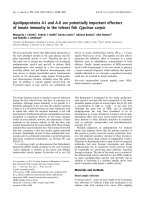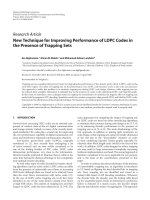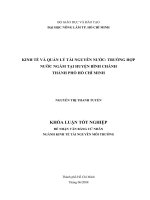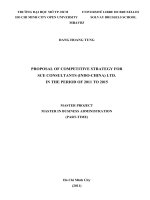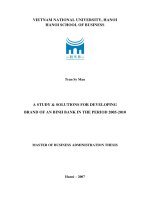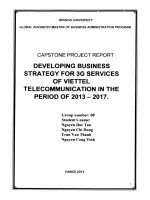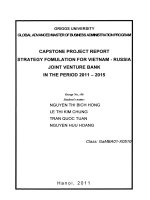A study & solutions for developing brand of Anbinh bank in the period 2005-2010 : Luận văn ThS. Kinh doanh và quản lý : 60.34.05
Bạn đang xem bản rút gọn của tài liệu. Xem và tải ngay bản đầy đủ của tài liệu tại đây (931.29 KB, 139 trang )
vietnam national university, HANOI
hanoi school of business
Tran Sy Mau
A STUDY & SOLUTIONS FOR DEVELOPING
BRAND OF AN BINH BANK IN THE PERIOD 2005-2010
master of business administration thesis
Hanoi – 2007
vietnam national university, HANOI
hanoi school of business
Tran Sy Mau
A STUDY & SOLUTIONS FOR DEVELOPING
BRAND OF AN BINH BANK IN THE PERIOD 2005-2010
Major: Business Administration
Code: 60 34 05
Master of business administration thesis
Supervisor: dr. nguyen viet anh
Hanoi – 2007
TABLE OF CONTENTS
ACKNOWLEDGEMENTS .........................................................................................i
ABSTRACT ............................................................................................................... ii
TÓM TẮT ................................................................................................................. iii
DECLARATION .......................................................................................................iv
TABLE OF CONTENTS ............................................................................................v
LIST OF ABBREVIATIONS .................................................................................. vii
LIST OF FIGURES................................................................................................. viii
LIST OF TABLES .................................................................................................. viii
INTRODUCTION .......................................................................................................1
1. Background..........................................................................................................1
2. Objectives & aims ...............................................................................................2
3. Research question ................................................................................................3
4. Scope of work ......................................................................................................3
5. Data & process ....................................................................................................3
6. Methods & approaches ........................................................................................4
7. Significance .........................................................................................................4
8. Limitations ...........................................................................................................5
9. Expected results ...................................................................................................5
10. Follow –up (potential) .......................................................................................5
11. Short introductions ............................................................................................5
11.1. Introduction .................................................................................................6
11.2 Theoretical Foundation ................................................................................6
11.3. Research methodology................................................................................6
11.4 Solutions for Developing Brand of ABBank ...............................................6
11.5. Conclusion ..................................................................................................6
CHAPTER 1: THEORETICAL FRAMEWORK .......................................................7
1.1 Understanding Brands .......................................................................................7
1.1.1 What is brand? ............................................................................................7
1.1.2 Types of brand ............................................................................................9
1.1.3 Function of brand ........................................................................................9
1.1.4 What is branding? .....................................................................................10
1.1.5 Key Concepts in Building Brand ..............................................................11
1.1.6 The Corporate Brand ................................................................................12
1.2. Branding strategy............................................................................................16
1.2.1. Positioning ...............................................................................................17
1.2.2. Brand Equity ............................................................................................17
1.2.3. Value ........................................................................................................17
1.2.4. Brand Image and Identity ........................................................................18
1.2.5. Brand Popularity ......................................................................................18
1.2.6. Service and Banking Branding ................................................................19
1.2.7. Yin and Yang Model to Branding ...........................................................19
v
1.3. Building banking brands ................................................................................20
1.3.1 Introduction about brand in banking.........................................................20
1.3.2. Factors in building strong brand ..............................................................25
1.3.3 Communicating banking brands ...............................................................36
1.3.4 What brand model for bank ......................................................................41
1.4. Experience in building and developing banking brands ................................43
1.4.1 Failures and Success in building brand ....................................................43
1.4.2 Experience in building brand ....................................................................44
CHAPTER 2: RESEARCH METHODOLOGY & EMPIRICAL FINDINGS ........48
2.1 Research Approach ..........................................................................................48
2.2 Research Method .............................................................................................49
2.3 Data collection method ....................................................................................49
2.4. Overview of the case ABBank .......................................................................51
2.4.1 Introduction ...............................................................................................51
2.4.2 History and development process of ABBank .........................................52
2.4.3 Mission, Vision and Objectives of ABBank ............................................54
2.5 Empirical findings ...........................................................................................57
2.5.1 Empirical Data ..........................................................................................57
2.5.2 Data analysis .............................................................................................58
2.6 Status of brand development in ABBank ........................................................72
2.7 Why are Vietnamese banking brands not great? .............................................74
2.7.1. Overview of banking brand in Vietnam ..................................................74
2.7.2. Actual existences of bank branding in Vietnam ......................................75
2.7.3. Why are Vietnamese bank brands not great? ..........................................80
CHAPTER 3: SOLUTIONS FOR DEVELOPING BRAND OF ABBANK ...........86
3.1 Orientations develop banking industry in coming time. .................................86
3.1.1 Objective and strategy in developing Vietnam‘s banks in coming time ..86
3.1.2 Government orientation in developing banking services .........................88
3.1.3 The future of banking branding ................................................................95
3.2 Difficulties and challenges in developing brand of ABBank ..........................97
3.2.1 Difficulties to ABBank .............................................................................97
3.2.2 Challenges to ABBank ...........................................................................100
3.3 Solutions for developing ABBank brand ......................................................101
3.3.1 Overall solutions for developing ABBank brand ...................................101
3.3.2 Application of Brand Resonance Pyramid model in ABBank ...............113
3.3.3. Recommendations..................................................................................117
CONCLUSIONS .....................................................................................................119
REFERENCES ........................................................................................................124
APPENDIX
vi
LIST OF ABBREVIATIONS
ABBank: An Binh Bank
CJS Bank: Commercial Joint- Stock Bank
EVN: Electricity of Vietnam Group
PR: Public Relation
SBV: State Bank of Vietnam
SOC Bank: State-owned commercial bank
VCB: Vietcombank
WTO: World trade organization
vii
LIST OF FIGURES
Figure 1- 1: Importance of brand to banks ........................................................20
Figure 1-2: Seven factors in building successful brands ...................................26
Figure 1-3: Brand resonance model ...................................................................42
Figure 2-1: Highlight of performances 2004-2006............................................54
Figure 2-2: Performance Results in the period 2004-2006................................55
Figure 2-3: Employees‘ Understanding about brand .........................................61
Figure 2-4: Understanding of employees about aspects of brand .....................62
Figure 2-5: Customers‘ choice...........................................................................66
Figure 2.6: Satisfaction level of Customers about bank ....................................67
Figure 2.7: Feeling of customers about ABBank brand ....................................68
Figure 2.8: Brand personality of ABBank .........................................................69
Figure 2.9: Difference between ABBank and others .........................................69
LIST OF TABLES
Table 2.1: Employees‘ understanding about brand ...........................................63
Table 2-2: Difficulties of employees in working ...............................................63
Table 2-3: Logo of banks ...................................................................................66
Table 2-4: Factor affect to customer‘s choice ...................................................70
Table 3-1: Comparison between ABBank and other CJS banks .......................99
APPENDIX
Appendix 1: QUESTIONNAIRE (For customers)
Appendix 2: QUESTIONNAIRE (For Manager and employees)
viii
INTRODUCTION
1. Background
In recent years, Vietnam‘s economy has been always at high growth rate,
banking is one of the industries has influence on the economy with the highest
growth rate in a long time. Besides that, go together high growth is competitive
pressure becoming increasingly among banks as well as foreign banks which has
not only a strong power of finance but also experience in a long time. Especially,
when Vietnam become formal member of WTO since the 1 January 2007, after that
there are many banks establish, and there are more foreign banks send file to State
Bank of Vietnam to ask the Vietnam State Bank to permit them open branch or even
establish a new foreign bank with 100% their capital. What‘s more, with pressure
from domestic competitors as well as foreign banks, domestic must have planning
to compete in fierce competitive environment. An Binh bank (ABBank) is not
exception. To compete with competitors from domestic to foreign, each bank must
have good brand. Below are some reasons, which make me to, decided chose this
topic what makes ABbank to develop its brand in coming time
First, under competitive pressures from foreign banks, domestic banks more
increasing, ABBank cannot develop without development planning of brand and a
certain brand image in customers ‗mind. Therefore, ABBank needs to have a plan to
develop its brand in coming time, before cope with direct competition from foreign
banks.
Second, Vietnam participates into WTO (world trade organization), more
and more foreign banks penetrate into Vietnam market, and this makes a large
pressure for Vietnam‘s banks.
Third, ABBank changed operation in commercial and investment banking in
a short time and it is new one in Vietnam financial market. Therefore, ABBank
must do many things to build and develop a believable image in customers trust.
Furthermore, ABBank has difficulties in finding solutions for developing brand as
well as improve brand image in customers‘ mind. Therefore, ABBank has to not
only compete with domestic commercial banks but also prepare finance and human
resource to guarantee existence and development in fiercely competitive
environment as well as cope with foreign banks. At this moment, ABBank has not
yet an overall plan to develop its brand. Therefore, it must have a plan to develop
brand if it wants to exist and develop in fierce condition in today. Moreover, there
are sub-reasons what make me interest in studying brand in banking, that is brand in
banking is new concept in Vietnam and the number of banks have strong brands is
very little.
2. Objectives & aims
The purpose of this study is to show the issues of ABBank case and propose
the solutions for developing brand of ABBank in the period 2007-2010. In the
study, I will concentrate studying brand problem of ABBank and raise solutions to
develop its brand in coming time. Furthermore, the purpose is to provide an overall
seeing about bank brands in Vietnam financial market as well as foundation for
future research in the banking brand in Vietnam in the future. In this thesis, the
objectives and aims as following:
Objectives of the study
This study focus mainly on three objectives as following:
Studying deeply and more detail how brand development is conducted in
banking field.
Finding issues in process of building brand at ABBank as well as aspects,
which relate to ABBank.
Propose some solutions and brand model for developing An Binh brand in
coming time.
Aims of study
Applying successfully solutions in the process of developing ABBank brand
Help ABbank become one of five leading commercial joint stock banks in
Vietnam in 2010.
Make ABBank brand becomes one strong brand in Vietnam
2
3. Research question
As mentioned above, there are several important issues need to consider
when developing a brand. Local bank brands not only have to compete with each
other but also to compete with international bank brands that have the advantage of
capital and management skills to attract the consumer. Because of new business in
investment and commercial, ABBank actually has not an overall brand strategy for
developing bank brand. The question to ABBank now is to find the solution for
developing Brand of ABBank in coming time. As an intangible and risky purchase,
the brand can reassure the customer and add functional as well as emotional value.
Based on the discussion so far, the research problem is stated as:
Research question 1: What solutions can help ABBank develop its brand in the
period from now to 2010?
However, to have solutions for developing brand of ABBank, the study
needs consider the issues discussed in this paragraph, the research problem is
further narrowed down as one following sub research question.
Research question 2: What are difficulties and challenges facing AnBinh?
4. Scope of work
The study is conducted only in ABBank as a sample of Vietnam banking
system. However, the thesis only study in Hanoi branch of ABBank about 150 to
200 personal customers will be chosen in some transaction offices of ABBank in
Hanoi to fulfill the objectives detailed above. The period is chosen for the study is
only in 5 years from 2005-2010 and in this thesis, the study focus on finding
difficulties and challenges and then propose solutions for ABBank to build and
develop its brand in the period 2005-2010.
5. Data & process
With the main objectives are to find solution for ABBank to develop its
brand in the period from now to 2010. Study takes information from many sources
as following:
Data source: Bank‘s information & findings, Internet, papers
3
The way to process data: The method to process data is mainly by excel
Data has been taken from some websites, which specialize on branding in the world
and Vietnam such as Brand channel, Interbrand, Businessweek or vneconomy,
saigontimes and so on. Information from survey/interviews more than 100
customers in Hanoi as well as over 100 employees of ABBank in Hanoi branch.
6. Methods & approaches
The study uses case study to make clear the problem of brand in banking
system in Vietnam. Moreover, to have information for this study, this study
concentrates on survey customers and employees by some ways such as
questionnaires, interview and observation or in research method, we use case study
method. Especially, in the survey, we use three methods that includes
questionnaires, interview, observation.
This study will be an empirical research, which preliminarily adopts the
following: Review of related literature/documentation, survey, in-depth interview,
Review of related literature/documentation: this will examine the multidisciplinary
theories of and empirical studies on brand in the literature. In Surveys/interviews
sessions: questionnaires will be developed and structured interviews are conducted.
7. Significance
With the objective mentioned above, the study contributes several meanings
to banks in Vietnam. On the theory, this study makes clear some aspects of the
theory of banking brand in general and in ABBank in particular. This study is also a
good reference for banks in Vietnam when they have demand to build brand. It is
hoped that this study will contribute to the body of knowledge on brand and show
how the brand concept could be deployed more effective in other parts of Vietnam.
It will also help Vietnamese banks to understand fully about brand importance and
come up with more suitable brand strategies and policies. On the practice, this
study gives an overall strategy for ABBank developing its brand in the future.
4
8. Limitations
Thesis has some limitations as following:
The scope of work, which only in Hanoi branch of ABBank is narrow. Not
study in head office.
The time of the study from 2005-2010 is another limitation.
Customers in surveys are mainly personal not consist of enterprises.
Numbers of customers to interview and survey is not large.
9. Expected results
The study expects to show the following findings:
Propose solutions for building and developing brand in ABBank.
Understanding more detail and deeply about brand in banking
Finding the difficulties and challenges in the process of brand in ABBank
Giving out the best solutions for developing brand in ABBank
10. Follow –up (potential)
Further study will be taken on building and developing ABBank brand after
a period. Other way of study will be analyzing the importance of brand to banks in
ABBank particularly and all over banks in Vietnam in generally. This study is an
information channel and reference source for banks in Vietnam when they want to
develop their brands. Apply successfully in ABBank in the further future.
11. Short introductions
With objective is considering brand development in ABBank, therefore, this
study concentrates on studying brand problem in ABBank case. The result of study
will respect the status of brand development all over Vietnamese banks.
Furthermore, the study will be conducted as a case study limited to ABBank and
certainly, will not directly be applicable to other banks in Vietnam. In addition, this
study will only examine branded difficulties and show solutions for ABBank. Due
to the standardized thesis format and for the sake of clarity, this thesis will be
divided into five clearly defined parts and chapters as follows:
5
11.1. Introduction
This part presents the topic and the research question to the readers. It seeks
to build interest in the topic and help the readers understand the motivation for
choosing the subject.
11.2 Theoretical Foundation
This chapter presents to the readers about basic theory of brand and brand in
banking, consist of factors, criteria and process to build a successful brand in
banking. The chapter focuses on considering internal factors and criteria as well as
others relate to building a strong brand in banking. Beside that, this chapter also
brings the theoretical foundation and different, more detail understanding of brand
in general and banking brand in particular.
11.3. Research methodology
This chapter explains the theoretical, empirical and analytical approaches
that were used for the study. It also seeks to establish the validity and reliability of
the paper. Moreover, this chapter shows the research methodology in detail and all
findings on the research based on reaching above objectives as well as mention
model for developing in the case. And present the overview of the case study
11.4 Solutions for Developing Brand of ABBank
This chapter bases on the results of the survey, interview, observation and
study in relation to research questions and the theory presented in chapter one and
two. More importantly, this chapter indicates difficulties and challenges of ABBank
and since then propose appreciate solutions, recommendations for bank in
developing its brand in the coming time.
11.5. Conclusion
This part will summarize the findings of the study and give out conclusions
about the study. Furthermore, through comparison between theory and practical
understanding this study gives out implications for further research of building and
developing brand in Vietnamese banks.
6
CHAPTER 1: THEORETICAL FRAMEWORK
Since 1 January 2007, Vietnam became formal member of WTO; this is an
opportunity for Vietnam economy as well as most enterprises. However, go together
opportunity is challenge and challenge in here is extremely large, if we have no well
preparation we will fail, especially to banking industry, which is easily affected by
international and multinational corporations such as HSBC of UK or Citibank of
America… With a strong power of finance and labors force as well as over one
hundred years experience they are easy to defeat domestic banks when they are
permitted to open their own banks in Vietnam market. It is necessary to build and
develop brand and this is an important task even necessary mission to all. Why?
Building brand in order to assert banks‘ position, credit, and reputation is the most
important task in this period. Through building brand, banks improve image,
competitive ability, develop market, keep market share sustainable and enhance
competitive ability to not only among domestic banks but also among foreign
banks.
Branding is a relatively new concept for the banking industry. Banks are
slowly realizing that they need to manage their strategic assets, too. Competition in
the global business environment is tough and achieving a unique position and
competitive advantage becomes more and more difficult and expensive. The high
level of investment necessary to maintain production capabilities and rising cost of
R&D for product differentiation makes strong marketing capabilities and unique
brands pre-requisites for modern companies to cover these heavy investments. How
can companies and management teams catch up?
1.1 Understanding Brands
1.1.1 What is brand?
According to the American Marketing Association, a brand is defined as a
name, term, sign, symbol, or design, or a combination of them, intended to identify
the goods and services of one seller or group of sellers and to differentiate them
7
from those of competition. In other words, where product features can be copied in
constantly diminishing periods, brands offer companies the possibility of
distinguishing themselves from their competitors. Whereas products offer tangible
benefits, such as different uses, and feature tangible attributes, such as price and
quality and physical characteristics, brands are much more complex. A brand is
often loaded with symbolic meaning; it can bring up associations with seemingly
unrelated subjects that have been linked with the brand, a perception of quality
beyond physical attributes, or other positive/negative associations.
A brand is ultimately built in the consumer‘s mind, where he or she gathers
up all the knowledge regarding the bank, its products and services, the
communication they have with the outside world, and the associations all those
elements bring up. Branding is ideally done in a manner that appeals to the needs
and wants of the proposed target audience, and thus communicates to that audience
issues that give them a positive impression. Building profitable brands is a hard
task, especially with the huge competition in today. Only approximately 5% of new
brands succeed, and even huge, well-known banks or companies often experience
the need to downsize their brand portfolios. However, the value of a strong brand
can be immense, so a look into what researchers has deemed effective ways of
building brands is in order.
A short history of brands
Mention brand we can know the short history of brand consists of three stages:
Brand as a mark
Brand as a marketing tool
Brand as a source of sustainable competitive advantage
Branding started to develop and come to the fore in the marketing process in the
USA in the 19th and early 20th centuries. Many famous brands date back to this
time, for instance, American Express and Coca-Cola. With growing consumer
sophistication branding became associated with a mix of values that gave
consumers a message about a product. Consumers saw the brand as encompassing a
8
specific set of values, which would lead them to reject an alternative unless their
perceptions were altered or other factors.
1.1.2 Types of brand
A brand in many ways is an external manifestation of an internal culture.
The essential point of a brand is that it inspires customer loyalty and/or a method of
distinguishing one product from similar rivals. For the owner of a brand, two
important characteristics should flow from the existence of the brand. There are two
types of brand.
Manufacturer brands
Manufacturer brands are created by producers and bear their chosen brand
name. The producer is responsible for marketing the brand. The brand is owned by
the producer. By building their brand names, manufacturers can gain widespread
distribution and build customer loyalty.
Own label brands
Own-label brands are created and owned by businesses that operate in the
distribution channel – often referred to as ―distributors‖. Own-label branding – if
well carried out – can often offer the consumer excellent value for money and
provide the distributor with additional bargaining power when it comes to
negotiating prices and terms with manufacturer brands negotiating prices and terms
with manufacturer brands.
1.1.3 Function of brand
Brand is very important to all banks. Especially in this stage, when
competitive pressure is large and a lot of difficulties and challenge come to
domestic banks. Therefore, to understand about function of brand is the way help
banks to use brand as a tool in the development process. Below are some functions
of brand and these expressing the importance of brand to a bank.
First, brand has recognizable and distinguishable function
Second, announcing and Conducting function
9
Third, Making feeling and confidence
Last, Economic function
1.1.4 What is branding?
Branding is determining the essence of your institution and communicating
it. Branding helps clearly communicate our heritage. Branding also captures and
communicates our distinct personality.
a. Branding Context
Relate to brand name, there are many factor such as customers service, price
quality, advertising, marketing sales, public relation, financial performance, facility
appearances, competitors offerings, internet presence, employees behavior,
employee appearance…
b. Service Branding
A holistic brand image integrates entities such as values, colors, name,
symbols, words and slogans. Many people argue that once an organization
establishes a favorable brand image its main task is to ensure consistency. They
further argued that since service firms often follow a monolithic branding strategy,
consumers mentally group all the corporation‘s portfolio together, expecting
uniformity, thus management of brand consistency is even more important.
Successful service brands also depend on good internal communication
programmers enabling greater consistency delivering the service experience,
regardless of the customer‘s point of contact. Having well designed induction and
training programmers creates greater commitment, which is an important
component in services brands.
Many services branding issues require a company-wide approach to their
solution and implementation. Such issues include closing service quality gaps; a
focus on internal and external stakeholders, including staff; a need to monitor the
whole service delivery process and the role of strong organizational values in
motivating staff to deliver the services brand.
10
1.1.5 Key Concepts in Building Brand
Brand is common term and in that term, there are quite many concepts
related to it. In this study, the research focuses mainly on finding difficulties and
challenges as well as solution for develop bank brand. This section will examine
key concepts in this process. Bank brands are different application of the brand
concept; however, the theory presented applies to bank.
Brand Personality is defined as ―the set of human characteristics associated
with a brand (Aaker, 1996, p.347). The brand image building strategy implies the
definition of a brand personality and a user personality. The match between brand
personality and consumer personality is also an underlying concept of the
relationship marketing which is based on the self-image congruence notion. Brand
Personality is an important source of imagery, a soft attribute of image. According
to Aaker (1996), brand personality can create brand equity according to three
models: self – expression model, relationship basis model and functional benefit
representation model.
Brand Identity includes brand names, logos, positioning, brand associations
and brand personality. A good brand name gives a good first impression and evokes
positive associations with the brand.
Brand Awareness is a status when people recognize your brand as yours.
This does not necessarily mean they prefer your brand (brand preference), attach a
high value to, or associate any superior attributes to your brand, it just means they
recognize your brand and can identify it under different conditions. Brand
awareness consists of both brand recognition, which is the ability of consumers to
confirm that they have previously been exposed to your brand, and brand recall,
which reflects the ability of consumers to name your brand when given the product
category, category need, or some other similar cue. Aided awareness occurs when
you show or read a list of brands and the person expresses familiarity with your
brand only after they hear or see it.
11
Brand Positioning: A positioning statement tells in one sentence, what
business the company is in, what benefits it provides and why it is better than the
competitors are. The market position of a brand shows where a specific brand is
located. It also shows the relationship to competitive brands. We can determine the
market position of a brand based on the answers to the following four questions:
Why (which benefits and advantages does the new brand bring to the
consumer).
When (determining the opportunities for which the brand is most suitable)
For whom (it is about the determination of the consumer of a brand or target
group).
Against whom (determining the main competitive brands)
Brand Essence is the heart and soul of a brand—a brand‘s fundamental
nature or quality. Usually stated in two to three words, a brand‘s essence is the one
constant across product categories and throughout the world. Some examples are:
Nike: Authentic Athletic Performance
Disney: Fun Family Entertainment
Starbucks: Rewarding Everyday Moments
Brand essence determines the corporate vision. Without brand essence, we
cannot communicate the brand. Brand essence comprises brand personality,
characters, relationship, and brand image and brand position
1.1.6 The Corporate Brand
Referring brand name we must mention one concept, which often relate to
brand image or message of a bank or company that is corporate branding. What is
corporate branding? Corporate branding is a potentially strong tool for re-aligning a
corporate strategy and ensures that the corporation – big or small – is leveraging
adequately on the untapped internal and external resources. A strong CEO and a
dedicated management team are always seeking to raise their own bars and be
change agents for their corporations backed by a strong corporate branding strategy.
12
A well-drafted and professionally managed corporate branding strategy and
implementation plan can be a powerful component of the boardroom work.
According to this concept, corporate branding is often, but wrongly, referred to as
an exercise where the bank logo, the design style and color scheme are changed.
Naturally, these are important elements to evaluate and potentially change at a later
stage once the strategy has been decided upon. It is often accompanied with a new
corporate slogan, and then everyone expects results to occur during the project.
Corporate branding is a serious undertaking that entails more skills and activities
than just an updated glossy marketing facade with empty jargon.
A strong corporate branding strategy can add significant value in terms of
helping the entire corporation and the management team to implement the long-term
vision, create unique positions in the market place of the bank and its brands, and
not the least to unlock the leadership potential within the organization. Hence, a
corporate branding strategy can enable the corporation to further advantage on its
tangible and non-tangible assets leading to branding excellence throughout the
corporation.
a) The Corporate Brand in the Banking Sector
Branding is the cornerstone of service marketing for the 21st century; the
corporate brand is the primary brand for banks. In banking, the corporate brand
builds on the identity of the corporation to offer a distinct promise to customers,
shaped by all members of the organization. Both bank brands and corporate brands
involve multiple interfaces, and employees are an important part of communicating
the brand. Because of the intangibility, heterogeneity and inseparability of services,
there are specific challenges to branding services. Banks can use their corporate
brand to overcome intangibility. Without a brand, customers might view the service
as a series of standardized actions. There is higher risk associated with intangible
products. Customers must trust the bank through its brand, which helps consumers
to visualize the service. That is why VCB or BIDV brand make confidence in
customers‘ mind.
13
Risk also results from the heterogeneous nature of services. A service cannot
be produced in the factory and checked for quality before it is delivered to
customers. Staffs, whose understanding, commitment, behavior, attitude and
performance are vital to the success of a brand, deliver services. Services must
become more tangible through clear reference points, such as physical elements like
furniture and building design. Fixed elements create a consistent offering, which is
necessary to build the brand in the future.
Another important characteristic for branding services is inseparability,
meaning that the brand promise is delivered through staff and customer interaction.
Services are usually produced on a regular basis with the customer, while customers
who are not a part of the production process buy products. Therefore, service
providers have more opportunities to create a positive impression and strengthen
their brands. To take advantage of their potential, service companies should align
processes, organizational structures, and the physical environment to deliver a
consistent superior service. Due to the characteristic of inseparability, internal
implementation of the brand is very important for bank and its services. Thus, the
corporate brand in the banking sector plays an important role for a bank, and needs
to be carefully managed.
b) The Value of the Corporate Brand
Brand creates value for the organization and its customers through brand
equity. Brand is the most powerful weapon that the firm has at its disposal.
Corporate brands can be used as master brands and have a longer life than product
or service brands. As we know, product brands live in the present while corporate
brands live in the past, present and the future. Differentiation is not enough in
business today, it is also important that the sender of a message represents the real
source, which is the case for the corporate brand. Businesses that come from a
corporate body reassure stakeholders in insecure times.
Moreover, as businesses are becoming more global, banks tend to emphasize
corporate brands instead of service and product brands. The increased use of the
14
corporate brand is also a response to the imitation and homogenization of products
as well as the fragmentation of markets.
The corporate brand is a strategic resource that guides the business and
creates value. A general advantage to corporate brands is the economies of scale
that it generates in all aspects of communication, compared to the promotion of
individual line brands. As a result, of strong brand values, higher prices can be
charged for services, and sales volumes are likely to increase. It is easier to
introduce new services under the existing brand name, but it can be difficult to enter
new markets if the brand does not fit the new customer segment. In addition, if a
new line fails, then more damage could occur than with a firm that practices
individual branding. The power of the corporate brand is clearly demonstrated by
Interbrand‘s list of the world‘s 100 strongest brands, of which a vast majority is
corporate brands.
By creating clusters of functional and emotional values for their brands,
banks can add value to the lives of customers. Customers generally do not create
relationships with individual products or services, but it might do so with a brand
(which represents a set of promises). People argue that customers consume all facets
of the brands identity: physical aspects, personality, and implicit relation.
Consumers perceive the brand‘s identity through its relation to the outside world
and through their self-image. Through this identity, the brand tries to achieve a
strong emotional bond to the consumer, which gives the brand a special quality.
Consequently, the brand becomes a guarantee of quality and reduces the perceived
risk of purchasing the service.
c) Communicate
Bring the corporate brand to life through a range of well-planned, wellexecuted marketing activities, and make sure the overall messages are consistent,
clear and relevant to the target audiences. Make sure the various messages are
concise and easy to comprehend. Do not try to communicate every single point
15
from the corporate branding strategy. Instead, a selective approach will make much
more impact using the same resources.
d) Measure the brand performance
A brand is accountable and this is no different from a corporate brand. How
much value does it provide to the corporation and how instrumental is the brand in
securing competitiveness? These are some of the questions that need to be answered
and that the CEO will automatically seek as part of a commitment to run the
strategy successfully. The brand equity consists of various individually tailor-made
key performance indicators and needs to be tracked regularly. A brand scorecard
can help facilitating an overview of the brand equity and the progression as the
strategy is implemented.
1.2. Branding strategy.
As wee know, a brand is described as a name, term, sign, symbol or design,
or a combination of these intended to identify the goods or services of one seller or
group of sellers and to differentiate them from those of competitors. We can further
look at a brand to identify the maker or supplier of a product, while presenting
specific features, benefits and services to consumers. Moreover, a brand is a
promise to the consumer of what the product, service, or company stands for, and of
the kind of experience, they can get from it.
A brand incorporates a personality based on cultural factors including film
stars, sport heroes, or fictional characters. Today‘s brands are viewed and
understood from an emotional perspective. Therefore, branding has to do with the
way that customers perceive and buy things, not simply a characteristic of certain
industries. A brand equals a ‗relationship‘, ‗reputation‘, a ‗set of expectations‘ and a
promise. Moreover, they state that a brand is a combination of tangible and
intangible attributes, symbolized in a trademark, which if properly managed, creates
influence and generates value.
16
1.2.1. Positioning
Positioning is the process by which a company offers its brands to the
consumer and positioning is an essential aspect of branding. It is necessary that the
message to be communicated by all the organizations activities because any of them
may be the particular characteristic that the customers analyses and develops their
perception. Moreover, the objective of the positioning as the process makes the
offer into a brand. Positioning is not about what you do to a product, but what you
do to the mind of the prospect. This means products and services are positioned in
the mind of prospects. According to Aaker (1996), brand positioning refers to both
the process and the result of building or rebuilding an image for a brand relative to a
target market segment.
1.2.2. Brand Equity
―Brand equity‖ refers to the value of a brand. Brand equity is based on the
extent to which the brand has high brand loyalty, name awareness, perceived quality
and strong product associations. Brand equity also includes other ―intangible‖ assets
such as patents, trademarks and channel relationships. Brands differ in the amount
of power and value they have in the market place due to different factors. Powerful
brands are known to have brand equity. Brand equity is a set of brand assets and
liabilities linked to a brand through its name and symbol, which adds or subtracts
from the value provided by a product or service to a firm and/or to that firm‘s
customers (Aaker, 1996). Nevertheless, the brand equity is based on the extent to
which it has brand loyalty, name, awareness, perceived quality, strong brand
associations, and other assets such as patents, trademarks and channel relationships.
Furthermore, brands that have strong brand equity are seen as a valuable asset to the
company and can be bought or sold for a price.
1.2.3. Value
Value is the trade-off between what a consumer gives and gets from a brand.
Intangible values are the benefits that customers experience that are not functional
17
or physical aspects of the brand, which can include the aspects of the brand
personality. These characteristics of the brand cannot be seen, tasted, felt, heard or
smelled before they are bought. For example, trust, freedom, power and excitement.
However, tangible values are the benefits that the customer experiences that are the
functional or physical aspects of the brand. These characteristics of the brand can be
seen, tasted felt, heard or smelled before they are bought. Perceived value is the
consumers overall evaluation of the benefits of a product, which is based on what
they receive (ex: quality, satisfaction, or convenience) and what is given (ex: price,
time, effort). Furthermore, perceived value is completely based on the individual.
Perceived quality is the consumers perception about a products overall excellence or
superiority in comparison to other products, and is based on the individual.
1.2.4. Brand Image and Identity
Personality and the positioning of the brand make up the brands identity and
image. Brand is built by creating a strong brand personality, or set of brand values,
and positioning the brand by creating a favorable perception in the mind of the
target audience. Brand images are the set of beliefs that a consumer holds about a
particular brand. Consumer‘s beliefs may differ based on their individual experience
or perception of the brand. Furthermore, the brand identity is the total proposition
that a company makes to consumers, or the promise it makes and is everything the
company wants to be seen. It may consist of features, benefits as well as all other
values that the brand possesses.
1.2.5. Brand Popularity
Brand popularity can be defined as the extent to which a brand has been
widely sought after and purchased by a significantly large population. Furthermore,
it is considered the accumulation of market acceptance and brand goodwill over a
long period. Brand popularity can occur from word-of-mouth, from prior users and
is the result of the superior image of the brand, which is reflected in the brands
marketing. Brand popularity will positively influence the brand performance in the
18
short run as well as in the long run, by creating a favorable brand image in the
minds of consumers. As a result, the brands popularity will have a positive
contribution to the brand's loyalty, image, or market sales.
1.2.6. Service and Banking Branding
A company uses product branding when they decide that the product should
stand on its own, and should be left to succeed or fail without any support from the
corporate brand or company name. Usually fast moving consumer goods are
associated with this level of branding. Corporate brand is when the brand name
gives all its identity to the products or service, and then the products receive
strength and association through the companies brand values. In extreme cases of
corporate branding, the company‘s name is strongly associated with the product,
while there is no mention of products and services at all.
1.2.7. Yin and Yang Model to Branding
According to Asian culture, Yin and Yang are complementary sides to every
individual, and it provides balance so that the individual is harmonized. Like Yin
and Yang, the human brain has two hemispheres; one on the left, another on the
right. The left side of the brain deals with logic and rationality, while the right side
is concerned with emotions, dreams and creativity. In branding the Yin represents
the rational, while the Yang represents the emotional. Both the left side and the
right side of the brain are important for people to have because it creates balance.
Based on this concept, bank either builds their brand personality to appeal to the
rationality, or the emotions of consumers, while others use both. This way of
looking at consumers began with packaged consumer goods, but has adopted
rapidly by practically every type of business in various industries, since it has
shown to provide many benefits. With specific products are services, therefore, the
bank need to build a brand must based on combination of opposite factors. That is
philosophy make many successful brands in Asia, especially in Japan with famous
brand in the world such as Toyota, Sony.
19


